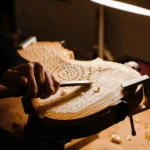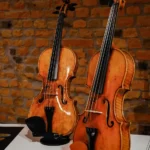20th Century Classical Music: A Brief History Lesson
Back to BlogDiscover the main characteristics and movements of 20th-century classical music, from modernism to minimalism.
Learn how composers transformed musical language and explore how to find your own style with the perfect instrument.
20th-century classical music had a significant impact on the artistic and cultural world. The 20th century saw many new classical music styles emerge from the previous century’s romantic period and traditional forms such as opera and symphony.
In the late 19th and early 20th centuries, composers responded to divided political climates around the world and technological advancements by creating new musical styles, each reflecting its own time period and culture.
In this article, we break down the essential characteristics of the period and examine the movements that mirrored the cultural and artistic transformations of the 1900s.
What is 20th-Century Classical Music
“20th-century classical music” refers to the tradition of Western art music composed roughly between 1900 and 2000. During this century, composers broke away from the Romantic and late-Romantic traditions of the 19th century and experimented with radically new sounds, structures, and philosophies. The result was a rich tapestry of movements, from Impressionism and Neoclassicism to Serialism, Minimalism, and Postmodernism, each reflecting its era’s cultural, political, and technological changes.
This period marked a profound shift: traditional tonality, orchestration, and classical forms such as symphony and opera were challenged, expanded, or reinvented, giving birth to some of the most influential and revolutionary musical works in history.
What are the Characteristics of 20th-Century Classical Music
Although 20th-century classical music is extremely diverse, there are several recurring features that help define it:
- Dissolution of traditional tonality: Many composers abandoned the traditional key-based system altogether. Instead, techniques like twelve-tone serialism granted equal importance to all twelve chromatic pitches.
- Experimentation with form and structure: Composers rejected standard classical forms or reworked them. Some works used nontraditional structures, continuous forms, or even indeterminate notation.
- New sonorities and timbres: The sound palette expanded dramatically: dissonance, rare instrument combinations, electronic instruments, atonality, noise, and unconventional playing techniques became common.
- Rhythm and texture innovation: Irregular meters, polyrhythms, mixed meters, frequent syncopation, and complex textures challenged listeners’ expectations.
- Repetition, minimalism, and gradual variation: As a reaction to complexity, some composers embraced simplicity. Short motifs, repeated patterns, static harmony, and slow transformation over time.
- Integration of new technologies and multimedia: With the advent of electronic instruments, tape recording, synthesizers, and other innovations, composers explored sounds and methods that were impossible in previous centuries.
- Political, cultural, and philosophical expression: Many works reflected or responded to the turbulent political climates of the 20th century, wars, revolutions, totalitarian regimes, or explored existential, psychological, and social themes.
Different Periods and Movements of 20th-Century Classical Music
The 20th century did not follow a single, linear path in music. Instead, it saw a succession (and overlap) of movements, sometimes reactive, sometimes revolutionary. Below are some key phases, including those you asked about.
From the Romantic era to Impressionism & Early Modernism
Although Romanticism belongs to the 19th century, its influence lingered into the early 20th. As the century opened, many composers began to feel dissatisfied with Romanticism’s expressive excess and dense chromatic harmony.
Impressionism, led by composers such as Claude Debussy and Maurice Ravel, emerged as a bridge from Romanticism to modern music. Impressionist music emphasizes atmosphere, mood, color, and tone, often using non-traditional scales (pentatonic, whole-tone), unconventional harmonies, and blurred tonal centers.
From there, some composers moved toward greater abstraction and experimental forms, giving birth to early modernist currents.
Neoclassicism (roughly 1920s–1950s)
Neoclassicism represented a conscious return to the clarity, balance, and formal order of the 17th and 18th centuries, but through a modern lens. Composers retained classical forms (sonatas, concerti, dance suites, chamber music), diatonic harmony, and polyphonic textures, while blending in modern rhythms, dissonances, and orchestration.
This movement can be understood as a reaction against the chromaticism of late Romanticism and the fluid harmonic language of Impressionism, and as a kind of “call to order” after the creative upheavals of early modernism.
Serialism, Atonality & the Avant-Garde (early to mid-20th century)
One of the most radical developments in 20th-century classical music was the breakdown of tonality. This was pioneered by composers such as Arnold Schoenberg, who introduced the twelve-tone technique (dodecaphony). In serialism, the twelve notes of the chromatic scale are treated equally; composers generate series (tone rows) and use permutations (inversion, retrograde, transposition) to build musical material. The result: atonal, often highly dissonant music without a central key.
Later composers (such as Anton Webern, Alban Berg, and beyond) extended serial principles beyond pitch to rhythm, dynamics, and timbre. This led to works with austere textures, fragmented motifs, dramatic disjunctions, and often a cerebral, abstract quality.
This Avant-Garde also gave rise to indeterministic or chance music, and other experimental practices that rejected traditional compositional control. John Cage is the most emblematic figure of this trend.
Minimalism (from the 1960s onward)
By the mid-20th century, after decades of complexity and abstraction, a group of composers reacted by embracing simplicity. Minimalism sought to strip music down to its essentials: repeated motifs, steady pulses, tonal (or near-tonal) harmony, and gradual change over time.
In works by Steve Reich, Philip Glass, Terry Riley, La Monte Young, and others, minute alterations and phase shifts over long durations create a hypnotic, meditative effect, very different from the dramatic intensity of earlier modernist music.
Minimalism also paved the way for postminimalism and influenced film scores, ambient music, and even popular music, bridging the gap between “classical” and “contemporary.”
Postmodernism and Beyond (Post-World War II)
After World War II, the boundaries of classical music expanded even further. Composers began mixing styles, reinterpreting past movements, embracing eclecticism, and blurring the lines between “high” art and popular or folk elements. This is commonly referred to as Postmodernism in classical music.
Key characteristics include use of chance (aleatoric music), appropriation of older styles (quotation, pastiche), incorporation of non-Western and popular idioms, electronic instruments, multimedia, and often a more pluralistic, inclusive approach.
How Classical Music Evolved Throughout the 20th Century
The evolution of 20th-century classical music can be understood as a gradual process of breaking away, and sometimes returning, to tradition, intertwined with experimentation, reflection of historical events, and technological innovation. Here’s how the progression unfolded:
- Departure from Romanticism: At the dawn of the century, many composers felt that Romanticism’s expressive excess and dense chromatic harmony were exhausted. They began experimenting, leading to Impressionism and early modernist tendencies.
- Search for clarity and structure: Reaction against both Romanticism and early modernist chaos brought a renewed interest in the formal balance, restraint, and classical forms of 18th-century music, but reimagined under modern sensibilities.
- Radical rethinking: As composers like Schoenberg sought new harmonic and structural languages, traditional tonality was dissolved. Music became more abstract, intellectual, sometimes dissonant or atonal, reflecting the existential, often turbulent mood of the times. This phase corresponded to major world events — wars, political upheavals — and composers used music as a direct or indirect response.
- Experimentation with sound, form, and medium: Beyond serialism, composers expanded into new territory: experimentation with timbre, rhythm, unconventional instruments, electronic media, chance procedures, and multimedia. This broadened the definition of “classical music.”
- Simplification and accessibility: By mid-century, some composers moved in the opposite direction — not toward complexity, but toward reduction. Minimalism restored the listener to a more meditative, accessible experience based on repetition, tonal harmony, and slow evolution.
- Pluralism and Postmodernism: In the postwar era, classical music became pluralistic. Composers blended styles, borrowed from non-Western traditions, integrated technology, embraced quotation and collage, and rejected grand narratives. The result was a more democratic, boundary-blurring, and inclusive classical tradition.
Legacy and influence: By the end of the 20th century, classical music had transformed from a rigid tradition anchored in tonality and form into a vast, diverse field. Its innovations influenced not only other classical composers, but also film composers, popular music, ambient and electronic genres — shaping the soundscape of the modern era.
The 20th Century Stills have an Impact Nowadays
The 20th century was a period of unprecedented transformation for classical music. Far from being a monolithic era, it was a dynamic century during which the very foundations of musical language like tonality, form, rhythm, instrumentation, were questioned and rebuilt.
Composers responded to changing political, cultural, and technological realities by inventing new styles. They reached backward to older forms and forward toward unknown sonic territories.
As a result, “classical music” in the 20th century ceased to be bound by fixed definitions. Instead, it became a fluid, evolving conversation, one that continues to resonate in contemporary concert halls, film scores, electronic music, and beyond.
Find your own movement and style with a unique instrument
Whether you feel drawn to the raw energy of modernism, the clarity of neoclassicism, or the meditative pulse of minimalism, the right instrument can help you express your musical identity with greater depth and confidence.
Just as 20th-century composers reshaped the language of music, today’s players continue that tradition every time they pick up an instrument that responds to their voice, their touch, and their imagination.
A finely crafted violin doesn’t just produce sound, it becomes a companion in exploration, capable of revealing new colors, textures, and possibilities each time you play.
If you are ready to take the next step in your musical journey, Amorim Fine Violins can help you find an instrument that matches your artistic path.
Their curated collection includes rare historical violins, modern masterworks, and exceptional bows, each one selected for its character, resonance, and craftsmanship.
Explore their vioin catalog, discover the instrument that resonates with your style, and let your sound evolve with the same spirit of innovation that defined the 20th century.









